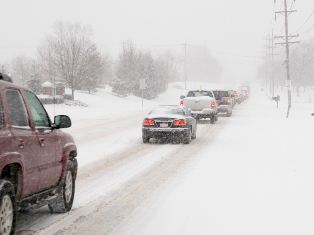Be Ready for the Winter Months
During the winter months, you can count on unpredictable weather patterns in multiple regions. Follow the below tips for handling heavy snow, icy roads, strong winds, rain and extreme cold. These conditions could cause property damage and put lives at risk. Knowing what to do in the event of a winter weather emergency is the best protection for your safety and security.
Prevent Flooding
-
Inspect your home or property to identify potential water intrusions.
-
Give attention to gutters, altering rooflines and keep sandbags ready.
Driving During Severe Weather
-
Avoid it and other methods of travel until conditions have improved, if possible.
-
Listen to weather reports and newscasts for the latest conditions and always allow for extra time to reach your destination.
-
Never warm up a vehicle in an enclosed area.
-
Wear your seat belt and keep your gas tank at least half full to avoid gas line freeze-up.
-
Know how your vehicle handles the ice and snow: Does it skid quickly? Pull to the left? Have touchy brakes?
-
Drive slower than the posted speed limit and leave plenty of room to stop, which is about three times more space than usual.
-
Keep your headlights on and clean to increase visibility.
-
Brake gently to avoid skidding and if your wheels start to lock up, ease off the brake.
-
Never use cruise control or overdrive on icy roads, and be especially careful driving on bridges, which tend to freeze quickly.
-
Make sure your windshield is clean and that your wipers are in good working order.
-
Tie a brightly colored cloth to the vehicle’s exterior if you get stranded. Move anything you need from the trunk into the passenger area and stay awake. Keep your body temperature up by wrapping yourself in extra clothing and run the vehicle heater for about 10 minutes every hour, ensuring you keep a window slightly open.
-
Prepare emergency kits for your office, home and vehicle.
-
Items to include: ice scraper, jumper cables, battery-powered radio, road flares, oil, antifreeze, first aid kit, gloves, blanket, fuses, flashlight and batteries, screwdrivers, pliers,wrench, tire inflator, rags, paper towels, duct tape, pocketknife, pen/paper, any personal medications, additional outerwear, waterproof footwear, matches, snacks or energy bars and bottled water.
During a Storm
-
Only use fireplaces or wood stoves if they are properly vented to the outside.
-
Do not use extension cords to plug in space heaters and never leave them unattended.
-
Never use a charcoal or gas grill indoors.
-
Do not leave lit candles unattended; use flashlights or lanterns instead of candles, if possible.
-
Leave all water taps slightly open so they drip.
-
Open cabinet doors underneath the kitchen sink to improve air circulation near pipes.
After a Storm
-
Check ceilings and exterior/interior walls for any leaks, stains or cracks, and seal any you find.
-
Protect your building’s pipes from freezing—locate the turnoff valve and drain the lines, protect spigots with Styrofoam attachments and wrap rubber sleeves over pipes.
-
Have your chimney or flue inspected yearly.
-
Clean out all of your gutters and drains to ensure water can move freely through them.
-
Install smoke and carbon monoxide detectors and test the batteries every month.
-
Insulate walls, attic and any water lines that run along the outer walls.
-
Caulk and weather-strip your doors and windows; install storm windows or cover them with plastic from the inside.
-
Contact an HVAC professional for a furnace inspection and change your furnace filters monthly.
-
Service your weather-specific equipment: drain gas from lawnmowers, tune-up snow blowers, replace worn shovels and buy bags of ice-melt or sand.
-
Trim any branches that hang close to the building or electrical wires.
For more winter preparedness tips...
Center for Disease Control
Fire Life Safety Training
Remember – safety and security is everyone’s responsibility!
#BeSafe!




















